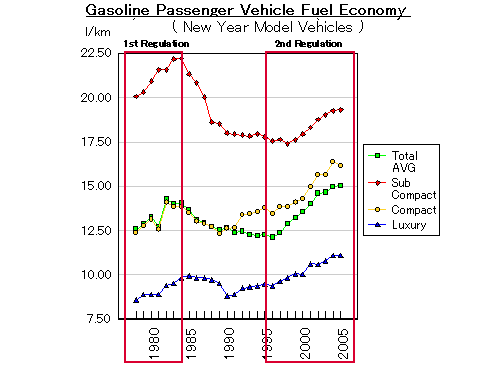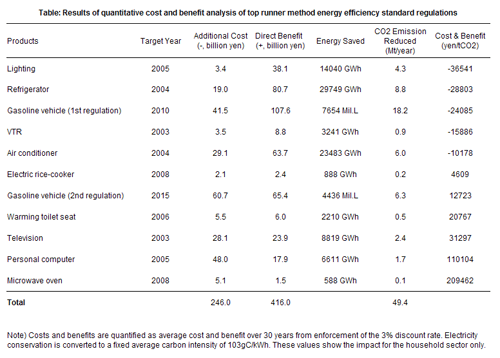Cost and benefit analysis for top runner method energy efficiency standard regulations
The impact of energy efficiency standard regulations in Japan has typically been evaluated in terms of the amount of energy conservation and/or carbon dioxide emission reductions.
The Ministry of Economy, Trade and Industry (METI) is currently promoting a project which attempts to estimate the costs and benefits of energy efficiency standard regulations as a quantitative policy impact assessment and is attempting to clarify the expense necessary to enforce such regulations.
In this project, I was in charge of analysis of household electronic appliance efficiency and passenger vehicle fuel economy standard regulations. Under Japan's Energy Conservation Act, the standards are set by the "top runner" method, which aims to improve average energy efficiency of future products above the level of the most energy-efficient products currently available on the market. Detailed results can be viewed in two RIETI discussion papers (published in Japanese). A summary table of the results follows.
The results contain a certain margin of error in estimation, but given that leeway for error, there are two noteworthy points:
a) Costs and benefits show negative cost in major regulated products
Major top runner method standard regulations such as on passenger vehicles under the 1st fuel economy regulations, electronic refrigerators, and air conditioners show their cost and benefit results as a negative cost.
b) Costs and benefits show excess positive cost in some regulated products
Some top runner method standard regulations, including those on personal computers and microwave ovens, show excess positive costs such as ¥100,000/ton of carbon dioxide reduction.
The result that costs and benefits are negative means that the energy conservation benefits in the household sector, such as avoidance of electricity tariff payments or reductions in fuel expenses, exceeds the necessary costs for manufacturers, such as for research and development (R&D) expenses or facility and equipment investments to achieve the standard, and that some not yet identified factors hindered energy efficiency improvement.
On the other hand, the result that costs and benefits are excessively positive means that the energy conservation benefits in the household sector fall short of the necessary costs for manufacturers to achieve the standards, and those standards are set at a level too hard to achieve or introduce unanticipated technological difficulties.
We can further explore these contrasting results.
Negative cost and risk of investment in high-efficiency products
If household consumers and manufacturers are economically "rational," consumers will purchase certain quantities of high energy efficiency household electronic appliances and fuel economy-regulated passenger vehicles while mindful of electricity tariffs and fuel expenses, and manufacturers will correctly anticipate this consumer behavior and supply more of these appliances and vehicles. Thus a degree of "natural selection" to eliminate less efficient appliances and vehicles should come into play.
Assuming that household consumers and manufacturing companies are economically rational, costs and benefits will be zero due to the natural selection that systematically eliminates less efficient home electronic appliances and passenger vehicles in the retail market. And under such assumptions, artificial introduction of new energy efficiency or fuel economy standard regulations by the government causes some positive cost; costs surpass benefits.
But, typically in the Japanese passenger vehicle retail market, we find no evidence of such natural selection and no fuel economy improvements so long as there are no fuel economy regulations (see figure below). This somewhat "irrational" phenomenon is explained as follows.
Consumer preferences are affected not only by fuel economy or reduced fuel expenses but by the composition of the family, traffic in residential neighborhoods, and their particular tastes for passenger vehicles. Vehicles are often chosen based on the sum of these factors, so high fuel economy vehicles do not always sell well in the retail market.
On the other hand, passenger vehicle manufacturers hesitate to make large-scale investments in fuel economy improvement if they sense a risk that consumers will not choose higher fuel economy vehicles, or a risk that competing companies could challenge them in aspects not related to fuel economy, such as vehicles' interior space, better drive handling performance, and so on. Amid such uncertainty, passenger vehicle manufacturers tend to avoid large-scale investments so as to avert increasing costs or relatively decreased sales compared to their competitors.
Figure: Relationship of fuel economy regulation and new passenger vehicle fuel economy

As a result, though both consumers and passenger vehicle manufacturers are aware of the clear benefits of decreased fuel expenses, the uncertainties of high fuel economy passenger vehicle sales tend to discourage manufacturers from making large-scale investments in fuel economy improvement.
Top runner method fuel economy standard regulations require all passenger vehicle importers and manufacturers to comply with the minimum standards for fuel economy and energy efficiency. These regulations also eliminated the uncertainties of high fuel economy passenger vehicle sales and reduced the risks that competing companies would challenge in certain aspects not related to fuel economy. Thus, owing to top runner method fuel economy standard regulations, the fuel economy level recovered to a level of natural selection from an artificially low level affected by such investment risks, and the resulting cost and benefit analysis shows a negative cost.
Excess positive cost and risk of government regulation failure
So can we assume that top runner regulations always eliminate the uncertainties of high-efficiency product sales and guarantee negative costs and benefits? Our analysis proves this is not always true. Most discussions on deregulation show evidence of bad government regulation. Japanese policy-makers have apparently been working hard to achieve such standard regulations, but some such regulations with excess positive cost in the cost and benefit analysis apparently indicate that the regulations actually harm Japan's economic welfare.
Normally, the Japanese government chooses to regulate products that consume large amounts of energy in the household sector, but it is extremely difficult to demonstrate or recognize the technological difficulty required to achieve the energy efficiency standards before trying the R&D in an objective manner. Even if manufacturers accurately identify technological difficulties, government officials cannot always properly understand these difficulties.
As a result, government officials often face the risk of choosing less cost-effective regulations and/or setting overly strict standards despite the fact they evidently paid due diligence. Moreover, cost-effective regulations on certain products might not yet have been formulated due simply to careless mistakes of government officials.
Top runner method fuel economy standard regulations under Japan's Energy Conservation Act are regarded as an effective policy measure to promote energy efficiency in general, and my analysis also proved that is true for a majority of the currently regulated products, but at the same time there still remain some shortcomings that to be addressed.
What kinds of policy measures are effective for household energy efficiency improvement?
So then what kinds of policy measures are effective for eliminating both the risks of investment in high energy efficiency products and the risks of government regulation failure so that energy efficiency can be improved in the household sector?
Two policy options enable removal of such risks, both of which need to be evaluated in terms of practicality and compared in terms of their respective risks.
a) Introduce taxation or tradable permits that would remove risks of government regulation failure
b) Introduce energy efficiency standard regulations that would remove risks of investment in high energy efficiency products
In policy option a), the cost and benefit levels are clearly indicated as a tax rate or an emissions trading market price, and risks of government regulation failure can be expected to be mitigated, but it is difficult to mitigate the risks of investment in high energy efficiency products. This is because under conditions where household revenues are enough high and tax rates or emissions trading market prices are relatively low, electricity tariffs and/or fuel expenses do not change that radically, household consumers might continue their usual energy consumption and easily afford any additional electricity tariffs or fuel price increases, and manufacturers might still face risks in investing in high energy efficiency products.
In fact, though the Japanese government charged an extraordinarily high gasoline tax rate compared to other countries, the fuel economy level of Japanese passenger vehicles continued to worsen in the 1990s, when there were no fuel economy standard regulations.
In policy option b), the risk of investment in energy efficient products might be mitigated, but there remains a risk of government regulation failure in which government officials might impose energy efficiency standard regulations with bad costs and benefits.
However, as far as the result of the analysis of Japanese household electric appliances and passenger vehicles is concerned, the risk of investment in high energy efficiency products seems to outweigh the risk of government regulation failure in Japan.
Despite recent trends toward deregulation in Japan, well-designed and cost-effective energy efficiency standard regulations still appear rational as energy efficiency policy measures for the household sector.



